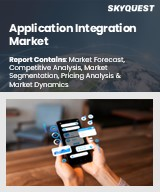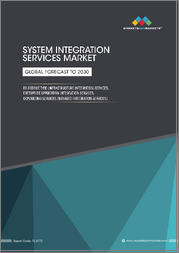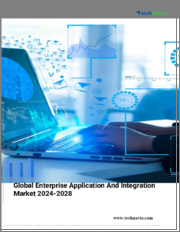
|
시장보고서
상품코드
1865229
애플리케이션 통합 시장 규모, 점유율, 성장 분석 : 통합 유형별, 배포 모델별, 컴포넌트별, 조직 규모별, 최종사용자 산업별, 지역별 - 산업 예측(2025-2032년)Application Integration Market Size, Share, and Growth Analysis, By Integration Type, By Deployment Model, By Component, By Organization Size, By End-User Industry, By Region - Industry Forecast 2025-2032 |
||||||
세계의 애플리케이션 통합 시장 규모는 2023년에 152억 달러로 평가되며, 2024년 179억 2,000만 달러에서 2032년까지 669억 1,000만 달러로 성장할 전망입니다. 예측 기간(2025-2032년)의 CAGR은 17.9%로 예측됩니다.
시장 분석에 따르면 기업은 업무 효율성 향상, 디지털 혁신 추진, 원활한 워크플로우를 보장하기 위해 애플리케이션 통합을 도입하는 것을 점점 더 우선순위로 삼고 있습니다. 통합 솔루션은 자동화 고도화, 수동 개입 감소, 조직 프로세스 효율화를 실현합니다. 기업이 전문 소프트웨어를 도입함에 따라 이러한 다양한 플랫폼을 효과적으로 연결하여 데이터 동기화, 개인화 서비스 및 고객 경험 향상을 촉진하기 위해 이러한 다양한 플랫폼을 효과적으로 연결해야 할 필요성이 증가하고 있습니다. 클라우드 애플리케이션과 기존 시스템을 연동하는 데 필수적인 이러한 솔루션은 증가하는 데이터 소스에서 적시에 정확한 데이터 공유를 촉진합니다. 또한 통합은 동적 데이터 흐름에 기반한 산업 규정 준수 모니터링을 지원합니다. 특히 iPaaS(Integrated Platform-as-a-Service)와 같은 첨단 통합 접근 방식은 진화하는 비즈니스 요구에 대응하는 적응형 솔루션을 제공하고, On-Premise와 클라우드가 혼합된 환경의 복잡성을 최적의 성능으로 탐색할 수 있도록 지원합니다.
세계 애플리케이션 통합 시장 성장 촉진요인
세계 애플리케이션 통합 시장의 주요 시장 성장 촉진요인 중 하나는 다양한 플랫폼과 용도 간의 원활한 데이터 교환에 대한 수요 증가입니다. 조직이 업무 효율화를 위해 다양한 소프트웨어 솔루션을 도입함에 따라 통합의 필요성은 매우 중요해졌습니다. 이러한 수요는 클라우드 컴퓨팅과 사물인터넷(IoT)의 등장으로 더욱 가속화되고 있으며, 여러 용도 간의 실시간 데이터 공유와 협업이 필수적으로 요구되고 있습니다. 또한 원격 근무로의 전환과 디지털 전환의 추진으로 기업은 통합된 데이터 생태계를 통해 프로세스를 효율화하고 생산성을 향상시키며 의사결정을 개선할 수 있는 애플리케이션 통합 툴에 투자해야 하는 상황에 직면해 있습니다.
세계 애플리케이션 통합 시장 성장 억제요인
세계 애플리케이션 통합 시장의 주요 시장 성장 억제요인 중 하나는 조직내 다양한 레거시 시스템의 복잡한 통합입니다. 많은 기업이 최신 플랫폼과의 원활한 통합을 염두에 두고 설계되지 않은 오래된 용도과 인프라에 의존하고 있습니다. 이러한 복잡성은 비용 증가, 도입 기간의 장기화, 업무에 대한 잠재적 장애를 초래하는 경우가 많습니다. 또한 기존 시스템과 최신 통합 툴에 모두 익숙한 숙련된 인력의 부족은 이러한 문제를 더욱 심각하게 만들고 있습니다. 이러한 통합 장벽을 극복하는 것은 조직이 업무 효율성 향상을 목표로 하는 가운데, 애플리케이션 통합 솔루션의 광범위한 도입에 있으며, 중요한 장벽으로 작용하고 있습니다.
세계 애플리케이션 통합 시장 동향
세계 애플리케이션 통합 시장에서는 서비스형 통합 플랫폼(iPaaS) 솔루션의 확산에 힘입어 두드러진 추세가 관찰되고 있습니다. 이러한 로우코드 플랫폼은 설정의 용이성, 적응성, 최소한의 코딩 요구 사항으로 인해 하이브리드 IT 환경에서 주목받고 있습니다. 조직에서는 MuleSoft, Dell Boomi와 같은 기성 커넥터 및 툴을 활용하여 클라우드 시스템과 On-Premise 시스템의 통합을 효율화하는 사례가 증가하고 있습니다. 이러한 전환은 업무 효율성을 향상시킬 뿐만 아니라, 기업에게 신속하고 비용 효율적인 통합을 실현할 수 있는 힘을 제공합니다. 그 결과, iPaaS는 현대 기업의 진화하는 요구에 부응하여 다양한 산업의 통합 전략을 재정의하고 있습니다.
목차
서론
- 조사의 목적
- 조사 범위
- 정의
조사 방법
- 정보 조달
- 2차와 1차 데이터 방법
- 시장 규모 예측
- 시장의 전제조건과 제한
개요
- 세계 시장 전망
- 공급과 수요 동향 분석
- 부문별 기회 분석
시장 역학과 전망
- 시장 개요
- 시장 규모
- 시장 역학
- 촉진요인과 기회
- 억제요인과 과제
- Porter의 산업 분석
주요 시장 인사이트
- 주요 성공 요인
- 경쟁의 정도
- 주요 투자 기회
- 시장 에코시스템
- 시장의 매력 지수(2024년)
- PESTEL 분석
- 거시경제 지표
- 밸류체인 분석
- 가격 분석
- 기술 평가
- 규제 상황
세계의 애플리케이션 통합 시장 규모 : 통합 유형별, CAGR(2025-2032년)
- 시장 개요
- 점대점(Point-to-Point) 통합
- ESB(Enterprise Service Bus)
- iPaaS(Integration Platform as a Service)
- 하이브리드 통합
세계의 애플리케이션 통합 시장 규모 : 배포 모델별, CAGR(2025-2032년)
- 시장 개요
- 온프레미스
- 클라우드
- 하이브리드
세계의 애플리케이션 통합 시장 규모 : 컴포넌트별, CAGR(2025-2032년)
- 시장 개요
- 플랫폼
- 서비스
세계의 애플리케이션 통합 시장 규모 : 조직 규모별, CAGR(2025-2032년)
- 시장 개요
- 중소기업(SMEs)
- 대기업
세계의 애플리케이션 통합 시장 규모 : 최종사용자 산업별, CAGR(2025-2032년)
- 시장 개요
- 은행·금융 서비스·보험(BFSI)
- IT·통신
- 소매·E-Commerce
- 의료·생명과학
- 제조업
- 정부·공공 부문
세계의 애플리케이션 통합 시장 규모 : 지역별, CAGR(2025-2032년)
- 북미
- 미국
- 캐나다
- 유럽
- 독일
- 스페인
- 프랑스
- 영국
- 이탈리아
- 기타 유럽 지역
- 아시아태평양
- 중국
- 인도
- 일본
- 한국
- 기타 아시아태평양
- 라틴아메리카
- 브라질
- 기타 라틴아메리카 지역
- 중동 및 아프리카
- GCC 국가
- 남아프리카공화국
- 기타 중동 및 아프리카
경쟁 정보
- 상위 5사의 비교
- 주요 기업의 시장 포지셔닝(2024년)
- 주요 시장 기업이 채택한 전략
- 최근 시장 동향
- 기업의 시장 점유율 분석(2024년)
- 주요 기업의 기업 개요
- 기업의 상세
- 제품 포트폴리오 분석
- 기업의 부문별 점유율 분석
- 매출의 전년대비 비교(2022-2024년)
주요 기업 개요
- Microsoft Corporation
- IBM Corporation
- Oracle Corporation
- SAP SE
- Dell Technologies Inc.
- Amazon Web Services(AWS)
- Google LLC
- MuleSoft(Salesforce)
- Informatica LLC
- TIBCO Software Inc.
- Boomi(Dell)
- Red Hat, Inc.
- ServiceNow, Inc.
- Software AG
- Workato Inc.
- Celigo Inc.
- SnapLogic Inc.
- WSO2 Inc.
- Jitterbit, Inc.
- Talend S.A.
결론과 제안
KSAGlobal Application Integration Market size was valued at USD 15.2 billion in 2023 and is poised to grow from USD 17.92 billion in 2024 to USD 66.91 billion by 2032, growing at a CAGR of 17.9% during the forecast period (2025-2032).
Market insights reveal that businesses increasingly prioritize application integration to enhance operational efficiency, drive digital transformation, and ensure seamless workflows. Integration solutions enable higher automation, reduce manual intervention, and streamline organizational processes. As firms adopt specialized software, the need to effectively connect these diverse platforms intensifies, fostering data synchronization, personalized services, and improved customer experiences. Essential for linking cloud applications with existing systems, these solutions facilitate timely and accurate data sharing amidst growing data sources. Moreover, integration aids in monitoring compliance with industry regulations based on dynamic data flows. Advanced integration approaches, particularly Integration Platform as a Service (iPaaS), offer adaptable solutions to meet evolving business demands, navigating the complexities of mixed on-premises and cloud environments for optimal performance.
Top-down and bottom-up approaches were used to estimate and validate the size of the Global Application Integration market and to estimate the size of various other dependent submarkets. The research methodology used to estimate the market size includes the following details: The key players in the market were identified through secondary research, and their market shares in the respective regions were determined through primary and secondary research. This entire procedure includes the study of the annual and financial reports of the top market players and extensive interviews for key insights from industry leaders such as CEOs, VPs, directors, and marketing executives. All percentage shares split, and breakdowns were determined using secondary sources and verified through Primary sources. All possible parameters that affect the markets covered in this research study have been accounted for, viewed in extensive detail, verified through primary research, and analyzed to get the final quantitative and qualitative data.
Global Application Integration Market Segments Analysis
Global Application Integration Market is segmented by Integration Type, Deployment Model, Component, Organization Size, End-User Industry and region. Based on Integration Type, the market is segmented into Point-to-Point Integration, Enterprise Service Bus (ESB), Integration Platform as a Service (iPaaS) and Hybrid Integration. Based on Deployment Model, the market is segmented into On-Premises, Cloud and Hybrid. Based on Component, the market is segmented into Platforms and Services. Based on Organization Size, the market is segmented into Small & Medium Enterprises (SMEs) and Large Enterprises. Based on End-User Industry, the market is segmented into Banking, Financial Services & Insurance (BFSI), IT & Telecommunications, Retail & eCommerce, Healthcare & Life Sciences, Manufacturing and Government & Public Sector. Based on region, the market is segmented into North America, Europe, Asia Pacific, Latin America and Middle East & Africa.
Driver of the Global Application Integration Market
One of the key market drivers for the global application integration market is the increasing demand for seamless data exchange across various platforms and applications. As organizations adopt diverse software solutions to enhance operational efficiency, the need for integration becomes critical. This demand is further fueled by the rise of cloud computing and the Internet of Things (IoT), which necessitates real-time data sharing and collaboration among multiple applications. Additionally, the shift towards remote work and digital transformation initiatives compels businesses to invest in application integration tools that streamline processes, improve productivity, and enable better decision-making through cohesive data ecosystems.
Restraints in the Global Application Integration Market
One of the key market restraints for the Global Application Integration Market is the complex integration of diverse legacy systems within organizations. Many businesses rely on outdated applications and infrastructure that are not designed for seamless integration with modern platforms. This complexity often results in increased costs, extended implementation times, and potential disruptions to operations. Additionally, the lack of skilled personnel who are proficient in both traditional systems and contemporary integration tools further exacerbates this challenge. As organizations strive to enhance operational efficiency, overcoming these integration hurdles remains a significant barrier to wider adoption of application integration solutions.
Market Trends of the Global Application Integration Market
The Global Application Integration market is witnessing a significant trend driven by the proliferation of Integration Platform as a Service (iPaaS) solutions. These low-code platforms are gaining traction in hybrid IT environments due to their ease of setup, adaptability, and minimal coding requirements. Organizations are increasingly leveraging pre-built connectors and tools, such as MuleSoft and Dell Boomi, to streamline the integration of cloud and on-premises systems. This shift not only enhances operational efficiency but also empowers businesses to achieve rapid and cost-effective integration. As a result, iPaaS is redefining integration strategies across sectors, catering to the evolving demands of modern enterprises.
Table of Contents
Introduction
- Objectives of the Study
- Scope of the Report
- Definitions
Research Methodology
- Information Procurement
- Secondary & Primary Data Methods
- Market Size Estimation
- Market Assumptions & Limitations
Executive Summary
- Global Market Outlook
- Supply & Demand Trend Analysis
- Segmental Opportunity Analysis
Market Dynamics & Outlook
- Market Overview
- Market Size
- Market Dynamics
- Drivers & Opportunities
- Restraints & Challenges
- Porters Analysis
- Competitive rivalry
- Threat of substitute
- Bargaining power of buyers
- Threat of new entrants
- Bargaining power of suppliers
Key Market Insights
- Key Success Factors
- Degree of Competition
- Top Investment Pockets
- Market Ecosystem
- Market Attractiveness Index, 2024
- PESTEL Analysis
- Macro-Economic Indicators
- Value Chain Analysis
- Pricing Analysis
- Technology Assessment
- Regulatory Landscape
Global Application Integration Market Size by Integration Type & CAGR (2025-2032)
- Market Overview
- Point-to-Point Integration
- Enterprise Service Bus (ESB)
- Integration Platform as a Service (iPaaS)
- Hybrid Integration
Global Application Integration Market Size by Deployment Model & CAGR (2025-2032)
- Market Overview
- On-Premises
- Cloud
- Hybrid
Global Application Integration Market Size by Component & CAGR (2025-2032)
- Market Overview
- Platforms
- Services
Global Application Integration Market Size by Organization Size & CAGR (2025-2032)
- Market Overview
- Small & Medium Enterprises (SMEs)
- Large Enterprises
Global Application Integration Market Size by End-User Industry & CAGR (2025-2032)
- Market Overview
- Banking, Financial Services & Insurance (BFSI)
- IT & Telecommunications
- Retail & eCommerce
- Healthcare & Life Sciences
- Manufacturing
- Government & Public Sector
Global Application Integration Market Size & CAGR (2025-2032)
- North America (Integration Type, Deployment Model, Component, Organization Size, End-User Industry)
- US
- Canada
- Europe (Integration Type, Deployment Model, Component, Organization Size, End-User Industry)
- Germany
- Spain
- France
- UK
- Italy
- Rest of Europe
- Asia Pacific (Integration Type, Deployment Model, Component, Organization Size, End-User Industry)
- China
- India
- Japan
- South Korea
- Rest of Asia-Pacific
- Latin America (Integration Type, Deployment Model, Component, Organization Size, End-User Industry)
- Brazil
- Rest of Latin America
- Middle East & Africa (Integration Type, Deployment Model, Component, Organization Size, End-User Industry)
- GCC Countries
- South Africa
- Rest of Middle East & Africa
Competitive Intelligence
- Top 5 Player Comparison
- Market Positioning of Key Players, 2024
- Strategies Adopted by Key Market Players
- Recent Developments in the Market
- Company Market Share Analysis, 2024
- Company Profiles of All Key Players
- Company Details
- Product Portfolio Analysis
- Company's Segmental Share Analysis
- Revenue Y-O-Y Comparison (2022-2024)
Key Company Profiles
- Microsoft Corporation
- Company Overview
- Business Segment Overview
- Financial Updates
- Key Developments
- IBM Corporation
- Company Overview
- Business Segment Overview
- Financial Updates
- Key Developments
- Oracle Corporation
- Company Overview
- Business Segment Overview
- Financial Updates
- Key Developments
- SAP SE
- Company Overview
- Business Segment Overview
- Financial Updates
- Key Developments
- Dell Technologies Inc.
- Company Overview
- Business Segment Overview
- Financial Updates
- Key Developments
- Amazon Web Services (AWS)
- Company Overview
- Business Segment Overview
- Financial Updates
- Key Developments
- Google LLC
- Company Overview
- Business Segment Overview
- Financial Updates
- Key Developments
- MuleSoft (Salesforce)
- Company Overview
- Business Segment Overview
- Financial Updates
- Key Developments
- Informatica LLC
- Company Overview
- Business Segment Overview
- Financial Updates
- Key Developments
- TIBCO Software Inc.
- Company Overview
- Business Segment Overview
- Financial Updates
- Key Developments
- Boomi (Dell)
- Company Overview
- Business Segment Overview
- Financial Updates
- Key Developments
- Red Hat, Inc.
- Company Overview
- Business Segment Overview
- Financial Updates
- Key Developments
- ServiceNow, Inc.
- Company Overview
- Business Segment Overview
- Financial Updates
- Key Developments
- Software AG
- Company Overview
- Business Segment Overview
- Financial Updates
- Key Developments
- Workato Inc.
- Company Overview
- Business Segment Overview
- Financial Updates
- Key Developments
- Celigo Inc.
- Company Overview
- Business Segment Overview
- Financial Updates
- Key Developments
- SnapLogic Inc.
- Company Overview
- Business Segment Overview
- Financial Updates
- Key Developments
- WSO2 Inc.
- Company Overview
- Business Segment Overview
- Financial Updates
- Key Developments
- Jitterbit, Inc.
- Company Overview
- Business Segment Overview
- Financial Updates
- Key Developments
- Talend S.A.
- Company Overview
- Business Segment Overview
- Financial Updates
- Key Developments


















